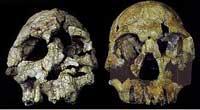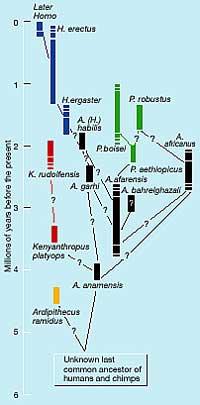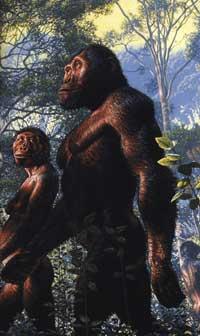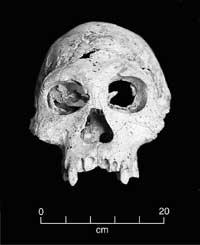New member in family
2001/03/22 Carton Virto, Eider - Elhuyar Zientzia

The traces of our potential ancestors always generate a great stir in the media and society. We want to know where we come from and where we go and at full speed the echo of the new discoveries extends. Today ends the journal Nature: The team of prestigious paleontologists, Meave and Louise Leakey, has declared that they have discovered a new species and genus of hominids that so far was not known, and has given name to the Kenyan man of Kenya, Kenyanthropus platyops or flat face. Paleontologists are convinced that they have discovered a new species and genus.
Anthropologist Daniel Lieberman of the University of George Washington, however, has shown several concerns about the discovery in his commentary in the journal Nature. In fact, 30 fragments have been found that could be part of a skull and teeth, but only two have been assigned for the time being K. Platyops to the hominid. According to Lieberman it is very possible that the discovered fossil belongs to a new species, but the genus also has doubts that it is new.
Three main groups
Until a few years ago it was thought that the evolutionary history of the human being was quite clear. Three genres of hominids were known: Australopithecus , Paranthropus and Homo (genus of modern man). It is believed that the genera Paranthropus and Homo evolved 2-3 million years ago and that the evolution occurred from the species Australopithecus afarensis, that is, of Lucy.
But in recent years everything has been wrong. First, three new species of Australopithecus were found in Kenya, Ethiopia and Chad, A. Anamensis, A.garhi and A. Bahrelghazali, respectively, and it became clear that in the genus there were more differences than expected. Subsequently, the genus Ardipithecus was discovered, which lived 4.4 million years ago and which, although little known, could be an initial hominid. Earlier this year, a group of French researchers presented a new candidate for older hominid, Orrorin tugenensis, although the discovery is still surrounded by controversy. And without solving it, Kenyanthropus platyops appears.

The characteristics of the Kenyanthropus platyops skull are not new, it is a combination of new features and is not found in any other species. Some features are like those of chimpanzees and others A. Anamensis and A. Like those of Afarensis, but it cannot be classified as a specimen of these species. On the other hand, the skull resembles much the Homo rudolfensis that lived 1.8 million years ago. This has similarities with the genus Paranthropus and the genera Paranthropus and Australopithecus are supposedly different. Or not? The new hominid has characteristics of different genera and species, but does not coincide exactly with each other. Those who have found it say it is a new genre, but things are not very clear. What is their place in the tree of the evolution of the hominid?
Is it a new genre? Or is it a new species of the genus Australopithecus? Or the ancestor of Homo rudolfensis? Lieberman proposes the construction of the tree of the image as a provisional solution, but as seen, it is also full of questions. The answer will come from the new discoveries and tools that new technologies have made available to you. Paleontologists and molecular biologists will have to work together if they want to release the thread and find all the ends.

Gai honi buruzko eduki gehiago
Elhuyarrek garatutako teknologia





